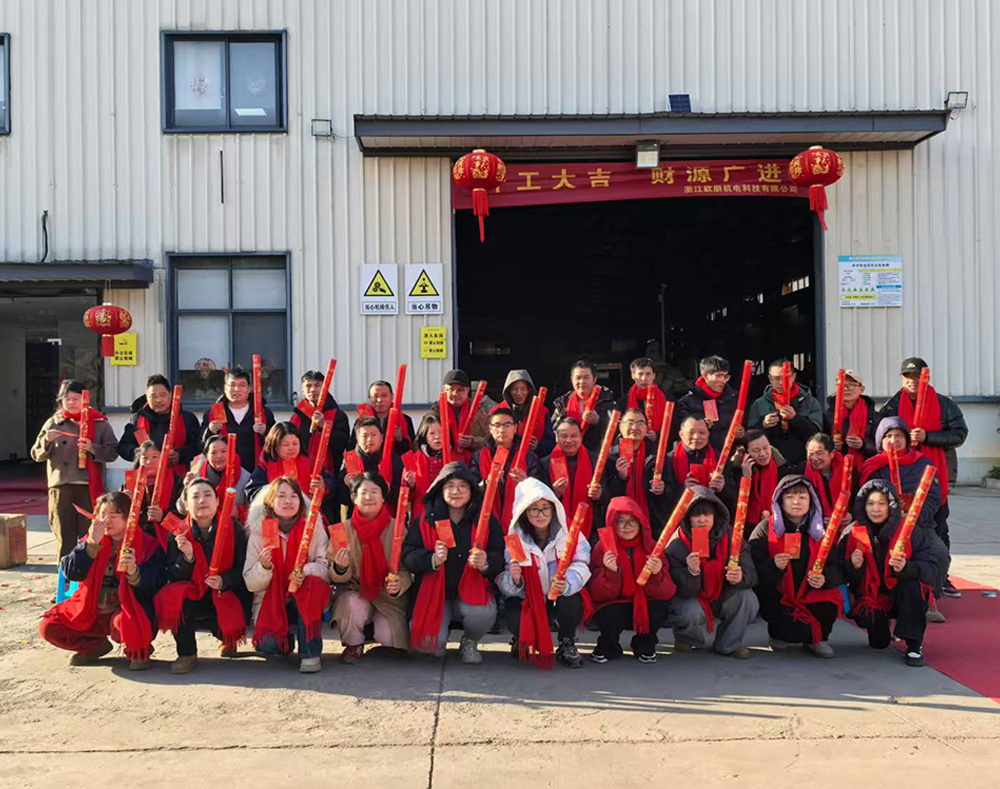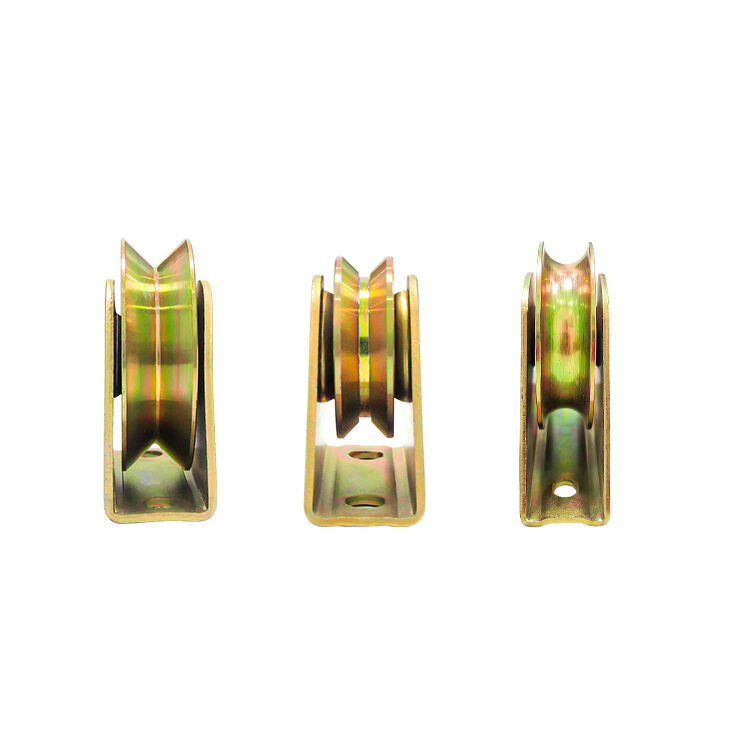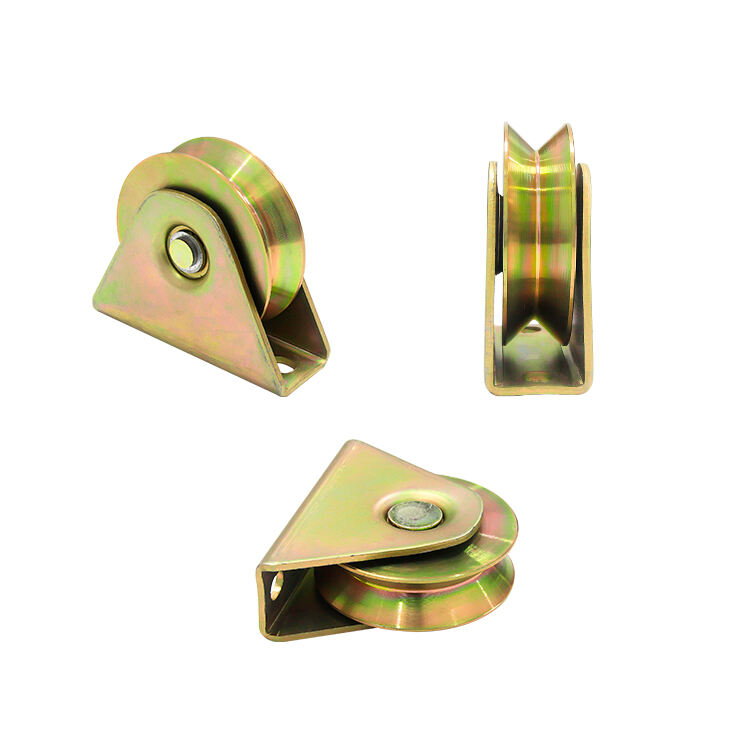ההתפתחות של עקרונות תכנון גלגלים כבדי משא
מהעלבון ועד אלומיניום מתקדם: הפיכת חומרים
בתחילת דרכם בתעשיית הגלילים, הברזל היציב הפך לחומר הנפוץ ביותר, מאחר שהוא היה חזק כל כך וארוך ימים. האנשים אהבו את העובדה שגלילי ברזל אלו יכלו להתמודד עם משקלים כבדים מכל סוג, מבלי להתפורר, מה שהוביל לכך שיתפשטו בכל מפעלים ומכשורים. אך היו גם בעיות. החומר היה כבד מאוד בעבודה, ובנוסף הוא נוטה להחליד בצורה חמורה עם הזמן. זה בדיוק מה שהוביל לחברה לחפש אפשרויות טובות יותר. כיום, רוב יצרני הגלילים נוטים להשתמש בсплавים מודרניים. למה? ובכן, חומרים אלו מקלים בצורה משמעותית על המשקל, ובעיקר הם עמידים יותר מול חלודה ושחיקה. בנוסף, הם נשברים פחות בקלות תחת לחץ, מה שמאוד חשוב בסביבות התעשייתיות הקשות, בהן הציוד נושא בעומסים כבדים יום אחרי יום.
כ-60 אחוז מהיצרנים של גלגלים התאגדו לسبائك חדשות אלו, על פי דוחות תעשייתיים עדכניים, וחברות מובילות כמו SKF ו-Schaeffler הן בפרצוף המתקפה. המעניין הוא עד כמה השחקנים המובילים ממשיכים להרחיב את הגבולות nhờ להתקדמות במדעי החומרים, שהופכת לחסכון בتكולים מבלי להקריב איכות. הספיכות החדשות גורמות לגלגלים כבדי משקל לעבוד טוב יותר לאורך תקופות ארוכות יותר בין תחלופות. צוותי תחזוקה מדווחים על פחות תקלות בפקעות המפעלים בהם מותקנים רכיבים שמשוחדרו. גם תיעוד הבטחה השתפר, מאחר שעובדים לא צריכים להתעסק בחלפים בלויים בתדירות גבוהה כמו בעבר. לאנשים המנהלים תפעול בקנה מידה גדול, קיימת עמידות כזו שמגיעה לחיסכון ממשי בדפי הוצאות בבתי מלאכה רבים.
השתלבות של מערכות קנטילברanism במנגנוני שערים מתחלפים
מערכות קונסולה משנות את אופן הפעולה של שערי הזזה מכיוון שהן מציעות יציבות טובה יותר ופישטות משמעותית את תהליך ההתקנה בהשוואה לשיטות ישנות. שערי הזזה מסורתיים זקוקים לנתיבים מפריעים שנמתחים לאורך הקרקע, אך שערי קונסולה תלוים מעל הקרקע. הם סומכים על גלילים ופסי תחביר חזקים כדי להישאר במקום. הסרת הנתיבים מהקרקע פירושה פחות מכשולים על פני הנתיב ופחות זמן תחזוקה. המערכת כולה פועלת היטב גם בממטר או בשלג שכן אין שום דבר שנתקע בחוץ ויפגוע מפגיעת מזג האוויר.
מרכזי לוגיסטיקה, מחסנים וצמתי תחבורה נוטים לבחור בשערים מחליקים קאנווטריים בעת ציוד המתקנים שלהם. כשמשלבים אותם עם מנוע שער מחליק באיכות טובה, מערכות אלו מעלות משמעותית את הביצועים, ומאפשרות שליטה בגישה חלקה ומהירה יותר באתרים עמוסים. לדוגמה אחת מהתשתיות הלוגיסטיות הגדולות ניתן לציין את שיפור של שליש באפקטיביות של הפעילות לאחר המעבר לשערי קאנווטר. העובדים שמו לב לכך שהמשאיות עוברות מהר יותר וכמה פחות זמן הושקע בתקלות בשערים. חוויות אלו מהשטח מדגימות היטב מדוע כל כך הרבה מפעילים תעשייתיים פונים כיום למערכות קאנווטר. פשוט הם מתאימות יותר לתפעול בקנה מידה גדול כאשר אמינות היא בעלת חשיבות מכרעת.
פריצות דרך בטכנולוגיית חלקי הסיכה עבור גלגלים
מערכות ארבע-סיכות דיוק לבקרת רעידות
המערכת הארבעת השעונים שינתה את הדרך בה אנו מתמודדים עם רעידות בRoleרים התעשייתיים הגדולים הללו. מה שמייחד את הריכוב הזה הוא האופן בו הוא מאזן את הלחץ בכל הנקודות, מה שמפחית את הרעידות המטרידות שממש 'אוכלים' את הרכיבים לאורך הזמן. מחקר של Exactitude Consultancy תומך בכך ומציג פחות או יותר 45 אחוז פחות בלאי כאשר משתמשים במערכות המתקדמות הללו במקום מודלים ישנים שיש בהם רק שני שעונים. זה אומר שהמכונות נמשכות יותר ויש שיפור בביצועים הכלליים. עבור כל אחד שעוסק בשערים מחליקים כבדים, שליטה ברעידות כזו יוצרת הבדל ענק בتكסיפתח תחזוקה ויעילות תפעולית.
דיסקיות אוטונומיות במערכת פתח שערים אוטומטית
แบรינגים שמאוישים עצמים שינו את המשחק כשמדובר בשימור מערכות שער זחילה אוטומטיות. עיקרון הפעולה שלהם פשוט למדי – כדוריות אלו מכילות מערכת שימון משלן, שמונעת חיכוך במהלך הפעלה, ולכן נגרמת פחות שחיקה ופחת משמעותי בבעיות תחזוקה בעתיד. לפי מחקר תעשייתי מסוים, מתקנים המ החליפו לכדוריות אלו רואים ירידה של כ-30% בהוצאות תחזוקה, פשוט בגלל שאין צורך להכניס שמן נוסף כל הזמן. שמות גדולים בתחום הכדוריות, כמו SKF ו-NTN Corp, מובילים את הדרך בטכנולוגיה זו. המוצרים שלהם עוזרים לשערים לפעול בצורה חלקה לאורך תקופות ארוכות יותר, ללא תקלות לא צפויות – משהו שהמנהלי נכסים מעריכים במיוחד בעונה העמוסה, כשכל דקה חשובה.
דיסקים חכמים מופעלים על ידי IoT לתחזוקה מנבאת
แบรינגים חכמים המחוברים לאינטרנט של הדברים משנים את אופן ביצוע התיקון, ובאופן בסיסי מאפשרים למכונות לומר לנו מתי הן זקוקות לתיקון במקום לחכות לתקלות. החיישנים שבתוך הברגים עוקבים אחרי דברים כמו רעדים, רמות חום, ומה סוג המשקל שהם נושאים כל היום. כשחברות עוברות לגישה החיזויית הזו, הן חוסכות כמויות עצומות של זמן מכיוון שהן מתקנות בעיות לפני שהציוד נשבר באמת. כמה מחקרים מדגישים שפעוטות המשתמשות במערכות חכמות אלו רואות את הזמן המת או ירידה של כ-25 אחוז לפי דוחות של Globe Newswire מהשנה שעברה. בהשקפה קדימה, יצרנים שמאמצים טכנולוגיה זו מוקדם ימצאו את עצמם ככל הנראה הרבה לפני מתחרים שעדיין סומכים על לוחות זמנים ישנים של תחזוקה. תעשיית הברגים עצמה עשויה להיראות שונה לחלוטין בעוד חמש שנים, כאשרכולם יבינו מה הרכיבים הקטנים המוכנסים בחיישנים יכולים לעשות לעליית הפרודוקטיביות.
חומרים חומרים מתקדמים מחדדים את הביצועים של גלגלים
גלגלים מפוחת-posite עבור יישומים חופיים
אזורים חופיים יוצרים בעיות אמיתיות לגלגלים מתכתיים רגילים עקב המלח והלחות באוויר. פליזים מסורתיים כמו פליז פלדה או אלומיניום פשוט לא יכולים לעמוד בזה, והם מחלידים במהרה כאשר הם נחשפים לרסיס ים ול לחות. כאן נכנסים לפעולה גלגלים מחומרים פולימריים מרוכבים. חומרים אלו עמידים בהרבה מידה בפני נזקי מי מלח, ועדיין הם חסינים מספיק לשימוש כבד. קחו לדוגמה את תעשיית המשאיות – תחנות מטענים ימיות החליפו לגלגלים מרוכבים בציוד שלהן, ומדווחים שגיל הפעולה שלהם ארוך בהרבה מגלגלים מתכתיים רגילים. אותו הסיפור מתרחש באתרי בנייה לאורך החופים – עובדים מציינים שמשלמים פחות כסף בסך הכול, מאחר שאין צורך להחליף את הגלגלים כל כמה חודשים עקב בעיות חלידות. הסיכום הוא שכלכלו את הכסף לאורך זמן, גם אם בהתחלה המחיר יהיה קצת גבוה יותר.
כיסויים נגד קריסה במנועי שערים צוללים
מנועי שער זזה נמשכים הרבה יותר זמן הודות לחיפויים אנטי-קורוזיה המגינים עליהם מנזקי מזג אוויר. פрайימרים עשירים בزنק עובדים היטב יחד עם חיפויים אפוקסידים כדי לעצור את היווצרות השחופה, דבר הכרחי לחלוטין כששערים צריכים להמשיך ולעבוד בצורה תקינה יום אחרי יום. מבחנים בשטח מראים שהשכבות המוגנות הללו יכולות להכפיל או אפילו לשלש את משך חיי המנוע במקומות שבהם אוויר מלח או טמפרטורות קיצוניות היו normally גורמות לבעיות. ראינו זאת בפעם הראשונה בחופים בהם מנועים מוחפים עם מוצרים מדרגת ים מיוחדים נותרו ללא שחופה שנים ארוכות, בעוד מנועים ללא חיפוי מתחילים להתקלקל תוך חודשים ספורים. יצרנים פותחים כעת אלטרנטיבות ידידותיות לסביבה שנמשכות אותו זמן ללא כימיקלים מזיקים, מה שעוזר לעסקים לשמור על מערכות שליטה וכניסה אמינות ללא קשר לאקלים שבו הם פועלים.
גלגלים היברידי סירמיים מהירים
גלילים היברידיים חשמליים שפותחו במיוחד למהירות גבוהה מביאים יתרונות אמתיים לתעשייה שצריכה תפעול מהיר. רכיבים אלו בולטים כיוון שהם עמידים בפני בלאי טוב יותר מהחלופות המסורתיות, ומסוגלים להתמודד עם מהירויות גבוהות מבלי להשתבש. לכן, יצרנים במפעלי ייצור רכב ובסביבות ייצור נפח גבוה אחרות סומכים עליהם רבות. מהם היתרונות העיקריים? פחות החיכוך בתפעול פירושו שהמכונות פועלות חלק יותר, וכמו כן משך החיים הארוך מקטין את עלויות ההחלפה. קפיצות מדרגה אחרונות בתחום החומרים החשמליים הביאו לבקשות פטנט חדשות, אשר מראות כיצד יצרנים משדרים את הרכב הכימי כדי להשיג תוצאות טובות יותר כאשר הדברים נעשים קשים. עבור חברות המפעילות ציוד במהירויות גבוהות יום אחרי יום, הגלילים הללו הפכו לבחירה המועדפת, ומעודדים את התקוות שלנו מהתעשייה הטכנולוגית של גלילים, הן מבחינת מהירות והן מבחינת עמידות.
יישומים חדשניים במכונה כבדה
מערכות משלוחים במכרות עם יכולת עומס דינמית
מערכות קונברטור הן השדרה של רוב תהליכי החציבה, במיוחד כשמדובר בניהול עומסי מינרלים משתנים שעלולים להשתנות בפער גדול במהלך היום. התקדמות טכנולוגית של גלילים בתקופה האחרונה שינתה באמת את היכולות של מערכות אלו, והפכה אותן לתלויות יותר בתנאים קשים. חלק מחציבות דיווחו שהמערכות החדשות שלהן יכולות לשאת כ-25% יותר משקל בהשוואה לציוד שהוצא משימוש לפני מספר שנים בלבד. עיצובים מתקדמים של גלילים פירושם שהמפעילים יכולים לדייק את המערכות לדרישות האתר הספציפיות, מה שמוביל לפחות תקלות תפעוליות ולפחות זמן השקע בתקינות. מפעל גדול סיפר לאחרונה על חווייתה עם גלילים ייחודיים שפותחו במיוחד לדרישות העבודה הכבדות שלו. הגלילים המיוחדים הללו הפחיתו את תדירות התחזוקה, תוך עידוד תפוקה יומית בכ-15%, לפי הדוחות שלהם.
השתלבות של מכסה דלתות כבדה בסביבות תעשייתיות
כאשר מתקינים מתקנים תעשייתיים צירים כבדים המשולבים עם מערכות גלילים, הם נוטים לחוות שיפור ממשי בפעילות היומומית. הקונפיגורציות האלה פועלות במיוחד טוב במקומות שדורשים שליטה מתמדת במעבר ובפתרונות חומרה אמינים, חישבו על הרצפות ייצור גדולות או על מراكז הפצה האדירים עליהם כל כך הרבה מדברים. קחו מחסנים למשל, רבים מציינים ירידה של כ-20% בפער תחזוקה לאחר מעבר למערכות דלתות מתקדמות יותר, מכיוון שהן פשוט נותרות מעודכן לאורך זמן ומתנועעות חלק יותר, מבלי להיתפס. יש גם הרבה מה לשקול מבחינת הנדסה. דברים כמו התפלגות המשקל במערכת וכדי לוודא שהיא תתאים למה שכבר קיים במבנה, חשובים מאוד במהלך ההתקנה. הצלחה בבחירה הזו פירושה שהתפעול בכלליות זורם חלק יותר, וגם שחלקי המתקנה האחרים לא נשלפים כל כך מהר.
צורות גלגל נסיעת שערים קנטילבר
בחירת מערכת גלגלים נכונה לשער הזזה קונסולי תורמת להפעלה חלקה ושקטה של השער האוטומטי, באופן שאינו מורגש כלל. התקנות שונות דורשות גישות שונות, תלוי אם מדובר בשער בית פרטי או משהו גדול כמו מתחם תעשייתי. מהנדסים בודקים כיצד המסה מופצת במערכת, מה תורם ליציבות, וכיצד המערכת עומדת בפני גורמים כמו רוח חזקה או עצים נישאים. בשערים המוגנים שבהם הבטחה היא בעלת חשיבות מרכזית, רבים מהמתקינים מעדיפים שלושה גלגלים במקום שניים, מאחר שזה תורם לאיזון טוב יותר ולתנועה מהירה יותר כשמגיע הרגע. מנהלי תשתיות שעובדו עם מערכות אלו, מציינים ירידה משמעותית במספר תלונות על רעש מצד השכנים, וכן פחות קריאות לתחזוקה לאורך זמן. בסך הכול, הם פשוט פועלים טוב יותר יום אחרי יום, מה שמסביר למה כל כך הרבה נכסים מסחריים מעדיפים אותם, למרות ההשקעה ההתחלתית.
חדשנות בתכנון מובילה על ידי בריאות הסביבה
מערכות גלגלים חסכוניות אנרגטית לצמצום חיכוך
מערכות גלילים שэкономות באנרגיה תורמות רבות להפחתת החיכוך, לשיפור הביצועים ולקידום של חברות ירוקות. כיום, במערכות מתקדמות משמשים חומרים קלים יותר, כגון שילובים קומפוזיטיים יחד עם משטחים מיוחדים שפשוט יוצרים פחות התנגדות בתנועה של החלקים. כאשר יש פחות מאמץ להנעת הרכיבים או סיבובם, משמעות הדבר היא שמכונים צורכים פחות חשמל באופן כולל. מחקר הראה כי המעבר למערכות גלילים מתקדמות יכול להוריד את עלויות האנרגיה בתפעול ב-30 אחוז בערך, מה שעוזר גם לסביבה. מנהלי מכונות מספרים לנו כי הגלילים המשופרים מביאים יותר מהחיסכון בדמי חשמל – הם נוטים להחזיק זמן רב יותר בין תמורה אחת לאחרת, ולכן החברות אינן נאלצות לקנות ציוד חדש כל הזמן. היפטרות מחיכוך מיותר נותרת חשובה, שכן כל חיסכון קטן מצטבר לאורך הזמן, במיוחד כשמגזרי התעשייה כולם נתונים ללחוץ להפחית את הפלטת הפחמן ולפעול באופן אחראי יותר כלפי הסביבה.
עיצובים מודולריים לתמיכה בייצור מעגלי
יצרני גלילים מתחילים לראות בעיצוב המודולרי שינוי מהפכני בנוגע ליעילות בתנאי כלכלה מעגלית. בעזרתו, ניתן להחליף או לשדרג רכיבים במקום זריקת מערכות שלמות לפח, מה שמפחית פסולת ומחסך משאבים לאורך זמן. כשמשהו מתקלקל, השיקום נעשה פשוט יותר מכיוון שכל החלקים מתאימים זה לזה כמו חתיכות פאזל. משמעות הדבר היא שהגלילים נותרים בתוקף למשך תקופה ארוכה יותר לפני שהחלפתם נחוצה, וזו דרכה לייצור בר קיימא כפי שמגדירים זאת רבים. חברות מסוימות כבר אימצו את העקרונות המודולריים וצברו תוצאות ממשיות. אחת החברות המובילות בענף עברה למבנה מודולרי והצליחה לצמצם את הפסולת ב-40 אחוז בערך, וכן הקטינה את משך הזמן שבו המכונות עומדות מוטרדים בתקופות תחזוקה. סיפורים מסוג זה מדגימים את חשיבות המודולריות לגישה המסלולית לייצור מעגלי כיום, ועוזרים למכשורים לפעול בצורה נקייה וחזקה בו-זמנית.
תוכן העניינים
- ההתפתחות של עקרונות תכנון גלגלים כבדי משא
- מהעלבון ועד אלומיניום מתקדם: הפיכת חומרים
- השתלבות של מערכות קנטילברanism במנגנוני שערים מתחלפים
- פריצות דרך בטכנולוגיית חלקי הסיכה עבור גלגלים
- חומרים חומרים מתקדמים מחדדים את הביצועים של גלגלים
- יישומים חדשניים במכונה כבדה
- חדשנות בתכנון מובילה על ידי בריאות הסביבה




